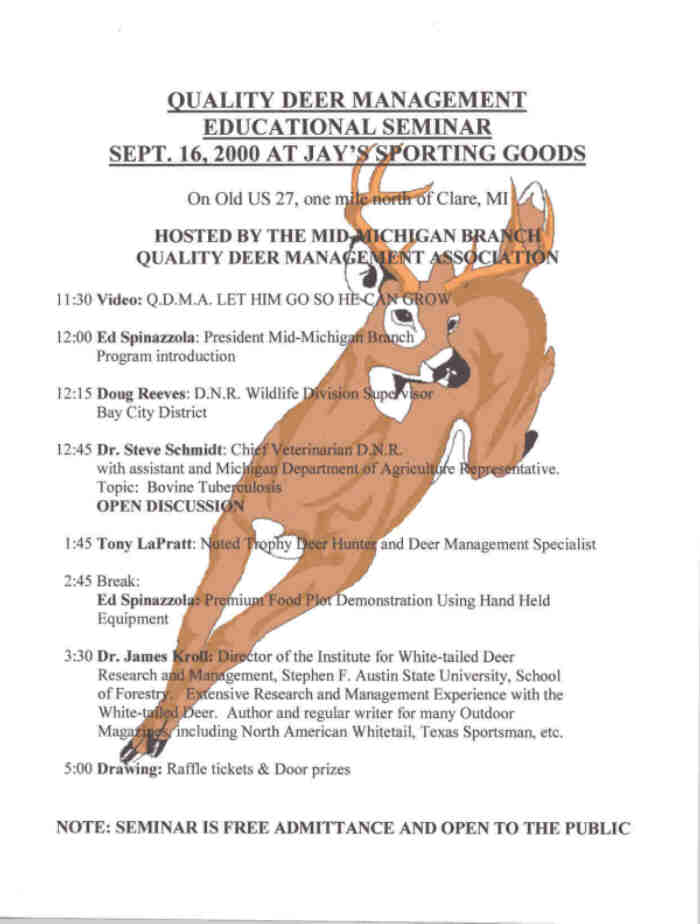

Clare County DMU 107 Facts
New Buck Rule:
Starting last year in 1999 for 5 years a demonstration area has been approved by the Natural Resources Commission NRC in DMU 107. There is now a new first buck rule with a minimum of (3) pt's. on one side with all pt's. to be 1" in length min. The second buck rule remains (4) pt's. on one side min.Object of New Buck Rule:
Improve and better balance the biological structure of the deer herd in DMU 107, also to be used as a demonstration and educational tool for all to learn. (3) pt's. on one side protects approximately 50% of the 1 ˝-year-old bucks in DMU 107. A balanced deer herd is one that is natural. It should have a buck to doe ratio of 1:2 or better. It should have good representation of all age classes in both the doe and buck groups. The population should be correct to maintain the health of the deer and not degrade the habitat, from deep woods to an agricultural area. Additionally, forcing hunters to look and identify before they shoot creates a safer area.Sponsoring Group for DMU 107:
Mr. Marc Yenkel of Clare, who has for 4 years petitioned and proposed to the DNR and NRC for higher buck standards. Marc has the support of concerned landowners and hunters, and the Mid-Michigan branch Quality Deer Management Association (QDMA).QDM Perspective:
In addition to the 3 pt's. rule there will be three antlerless permits available this year in DMU 107. One of the goals of QDM is to get the message to the landowners and hunters that they are the ultimate deer managers. The decision to apply for and utilize these permits, how many antlerless deer to be harvested, identifying correctly a legal buck, and whether to pass even on button bucks now requires some thought from you. It is the recommendation of the Mid-Michigan Branch that hunters in DMU 107 seriously consider having a voluntary first buck standard. Of 4 pt's. on a side min. this protects 85% of the young bucks and will show better results and sooner in 107.For many hunters this business of passing on young bucks is new, not necessary and takes away their opportunity to shoot the few small antlered legal bucks they presently see. The practices of QDM take the interests of landowners and hunters into consideration. How else could a deer management program of this type succeed? There must be satisfied hunters and landowners.
You are not being deprived of the opportunity to shoot a buck. Just another age class. Many studies have shown that the 1 ˝-year-old buck that is protected has a better than 95% chance of being around the following season. They don’t disappear and these passed up yearlings are seen again and again throughout the hunting season, which is viewed by many as an improvement in the hunting experience. The survival chances even get better as the deer population gets into a more natural balance. The older dominant bucks began to appear and suppress the breeding instincts of the young bucks, thus allowing them to enter winter in better physical shape.
You can improve your chances of keeping those passed on young bucks near your hunting spot by creating safe areas, cover and having year round good nutritious forage available. Also deer need space and by harvesting an adequate number of does you are encouraging these bucks to use your hunting areas as their bedroom.
The main focus of QDM is the welfare of the deer. However, it develops that when you take care of the deer, they take care of you.
Report on the first year 1999 DMU 107 demonstration:
Using data received from the DNR, on deer checked in at DNR field Offices, Highway Check Stations, and Deer Check Days at Jay’s, we have the following information.The male fawn (Button Buck) harvest was cut in half to only 10% of the total anterless harvest. For the first time there was an adequate harvest of does in relation to the buck harvest. The adult doe to buck harvest ratio was 1:1.3. This is exactly where it needs to be in order to achieve an adult buck to doe ratio of 1:2 in DMU 107. There was a 10% drop in the 1˝-year-old buck harvest along with a corresponding increase in the harvest of older bucks. The total anterless harvest increased from a base average of 104 to 213. The adult buck harvest increased from a base average of 131 to 203. A large part of this increase is due to the enthusiasm of DMU 107 hunters and landowners in our pioneer QDM demonstration. There will be a further reduction in the 1 ˝-year-old buck harvest as well as an increase in the older buck harvest as the program advances in the following years.
The Future:
Marc Yenkel along with the Mid-Michigan Branch intends to work intensely to make this demonstration a success. We will have surveys, QDM workshops, town meetings, and seminars, have events to collect deer aging data, collect deer heads for the TB data collection program and spread the word such as this flyer throughout the 5 years to insure success. Hopefully with DMU 107 and the surrounding areas being the focus of much attention we will encourage other areas and eventually the entire state to join us in sound and scientific deer management.Mid-Michigan Branch QDMA
Check our web page at http://www.qdma.net
© 1996 Michigan QDMA |